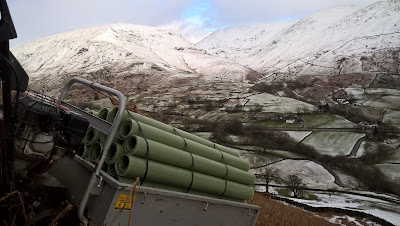On a wintry February half-term week and in full view of the
busy (and often snowy) Dunmail Raise near Grasmere, National Trust staff and
volunteers were hard at work on the slopes below Helm and Mungo Crags. Their
mission? To traverse these steep and rocky slopes in the name of restoring
scrub woodland…
 |
| Tree planting above Grasmere - there could be worse views! |
 |
| The power-barrows - and their operators - relish a challenge... |
Funded by Natural England, this involved planting 6ha of the slopes with typical ‘scrub woodland’ species – hawthorn, blackthorn, crab apple, holly and rowan, along with some silver birch, aspen and alder. Upland scrub is a valuable and often under-appreciated habitat; far from being “scruffy” and in need of tidying, the presence of scattered shrubs and trees provides valuable homes for insects, lichens, birds and small mammals, which in turn feed larger birds and mammals. The flowers of species such as hawthorn and crab apple keep pollinating insects happy, whilst their fruit can be a bounty in the autumn. And the roots of these trees and shrubs help to stabilise soils and improve the ability of slopes to hold water, reducing and slowing the water running off hillsides into rivers during rainy periods.
 |
| The scrub woodland will provide habitat and ecological benefits in the centuries to come |
Fresh from their success as ‘Volunteers of the Year’, the
Lake District’s Fix the Fells volunteers put in an impressive show of numbers
to help plant the 1,800 trees that went in the ground during the week. Students
from Myerscough College also came up during their holiday, learning how to
plant and linking this to their Upland Management course.
 |
| A good turn-out of staff and volunteers helped achieve a great number of trees being planted in difficult conditions |
We were also joined by volunteers from the University of Cumbria, as well as stalwarts of the Ullswater and Great Langdale volunteer teams. Staff from the National Trust’s regional office just over the valley in the Hollens also pitched in, experiencing first-hand a hillside they would normally look at from afar in their warm and cosy offices!
 |
| Planters struggle on, despite driving rain and steep slopes |
The planting was far from easy; on a couple of days the weather threw its
worst at us, as Allan Bank Manager Dave and Woodland Ranger Liam tried to
capture in this video!
The weather may have been trying, but all involved can look
up at this prominent hillside with pride. There are still more trees to plant,
hopefully in more amenable conditions!, but even so, look west next time you’re
passing on Dunmail Raise and you’ll see a great example of the National Trust’s
ambitions to restore a healthy, beautiful, natural environment.
 |
| The planted intake is visible from far below, and even from Dunmail Raise |










